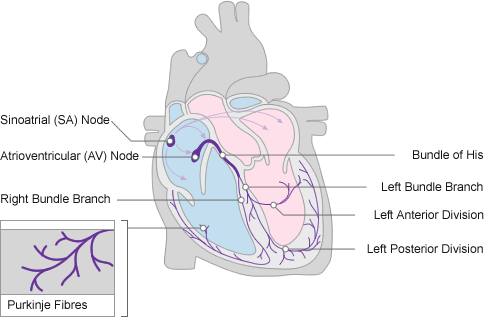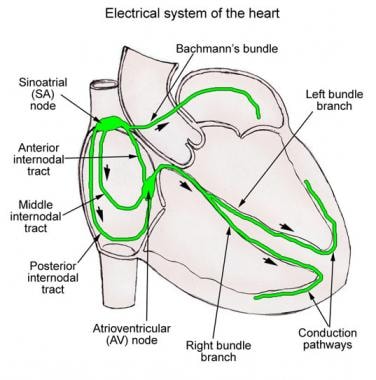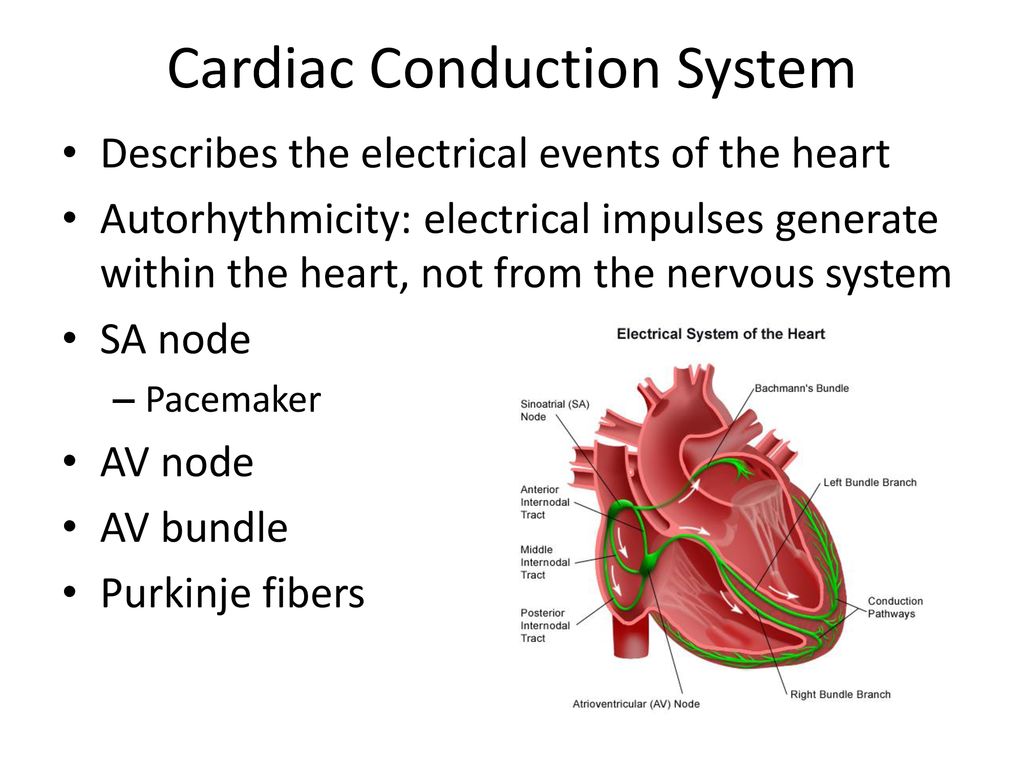Describe the Conducting System of the Heart
The normal electrical conduction in the heart allows the impetus that is engendered by the sinoatrial node SA node of the heart to be propagated to and stimulate the cardiac muscle myocardium. They initiate the normal cardiac cycle and coordinate the contractions of cardiac chambers.

Cardiac Conduction System Normal Function Of The Heart Cardiology Teaching Package Practice Learning Division Of Nursing The University Of Nottingham
Tap card to see definition.
:watermark(/images/watermark_5000_10percent.png,0,0,0):watermark(/images/logo_url.png,-10,-10,0):format(jpeg)/images/overview_image/2680/o6KmBa0TzRQVseboRYInAA_conducting-system-of-heart_english.jpg)
. This article will discuss the components of the hearts conduction system including their anatomy and clinical significance. Electrical conduction within the heart starts at the sinoatrial SA node and passes sequentially to the atriaventricular AV node Bundle of His left and. The atrioventricular AV node delaying the signal until your atria are empty of blood.
Small groups of specialized neuromuscular cells in the myocardium initiate and conduct impulses. It could be a mass of specialized cells which lie within the divider of the proper chamber close to the opening of the predominant vena cava. SA node- The SA node also call View the full answer.
The conducting system provides the heart its automatic rhythmic beat. 3 The SA node is called pace maker because it has power of generation of wave of contraction. Generate and propagate electrical impulses.
Describe the Intrinsic Cardiac Conduction Electrical Heart Click card to see definition. 1 Human heart is myogenic myo-muscle genic-originating from. It is a mass of specialized cells which lie in the wall of the right atrium near the opening of the superior vena cava.
This conduction system is composed of a group of special cells found in the walls of the heart muscle which send the electrical impulses and cause the heart muscle to contract. Conduction System of the Heart. - the heart can generate its own action potentials.
The electrical stimulus travels down through the conduction pathways and causes the hearts ventricles to contract and pump out blood. The main components of the cardiac conduction system are the SA node AV node bundle of His bundle branches and Purkinje fibers. For the heart to pump efficiently and the systemic and pulmonary circulations to operate in synchrony the events in the cardiac cycle must be coordinated.
The heart has two main types of cells. It is the set up rhythmic stimulation of the myocardium during the cardiac cycle. What are important parts of the conducting system and in what order to they become electrically excited.
After the electrical impulses spread across the atria they converge at the atrioventricular node. A cardiac conduction system is a group of specialized cardiac muscle cells in the walls of the heart that send signals to the heart muscle causing it to contract. The Electrical Pathway Conduction System of the Heart.
These special cells are able to generate an action potential on their own self-excitation and pass it on to other nearby cells conduction including cardiomyocytes. Describe the conducting system of the heart. Contract following receipt of electrical impulses.
Your atria top heart chambers telling them to contract. It ordinarily sets the heart rate and is subsequently called the pacemaker of our heart. Describe the electrical conduction system of the heart.
The sinus node generates an electrical stimulus regularly 60 to 100 times per minute under normal conditions. The atria contract and top up the ventricles. The left ventricle pumps blood to the aorta.
The action potential is generated in the autorhythmic cells of the SA node which is conducting across the whole heart by passing through different structures. The main components of the cardiac conduction system are the SA node AV node the bundle of. This problem has been solved.
This stage lasts for about 04 second. - the cells of the sinoatrial SA node generate action potential APs faster than other cardiac muscle cells - SA node is. Cardiac conduction system is a group of specialized cardiac muscle cells in the walls of the heart that send signals to the heart muscle causing it to contract.
When the impulses reach these fibers they trigger the muscle fibers in the ventricles to contract. What region is normally the pacemaker. Conducting system of heart.
The electrical impulse results in mechanical contraction of the cardiac muscle through a series of intracellular events involving calcium. The impulse conduction is described as follows- 1. The SA node anatomical pacemaker starts the sequence by causing the atrial muscles to.
Out the heart via specialized conducting tissue Fig 1 and into the heart muscle. At the base of the heart the atrioventricular bundles start to divide further into Purkinje fibers. The conducting system of the heart consists of cardiac muscle cells and conducting fibers not nervous tissue that are specialized for initiating impulses and conducting them rapidly through the heart see the image below.
The myocardium contracts after stimulation. 2 The heart beat originates in modified cardiac muscles called Sinoatrial node SA node which lies in the wall of right atrium near the opening of superior vena cava. Sinoatrial node SA node.
The heart possesses the property of autorhythmicity which means it generates its own electrical impulses. Anatomy of the Heart. The atrioventricular valves bicuspid on the left and tricuspid on the right are open and the semilunar valves pulmonary and aortic are closed.
The sinoatrial cells generate. The sinoatrial cells generate regular impulses which cause atrial compression. Before we discuss the cardiac conduction system lets briefly review the gross anatomy of the.
This takes about 01 second. Conduction system is a group of specialized cardiac muscle cells in the walls of the heart that send signals to the heart muscle causing it to contract. The right ventricle sends blood to the lungs via the pulmonary artery.
The bundle of His center bundle of nerve fibers carrying the signal to. The conduction system of the heart controls its pumping action which results in the delivery of blood to the different organs and tissues of the body. The excitation signal travels to.
State three reasons why a patient might need an electrocardiogram. Components of the Cardiac Conduction System Sinoatrial Node. Describe the electrical conduction system of the heart.
This is a small mass of specialized tissue located in the right upper chamber atria of the heart. The cardiac conduction system is a network of specialized cardiac muscle cells that initiate and transmit the electrical impulses responsible for the coordinated contractions of each cardiac cycle. - myocardial cells are auto-rhythmic.
The sinoatrial SA node is a collection of specialised cells pacemaker cells and is located in the. These cells can also propagate and on occasion generate electrical impulses. Detect myocardial ischemia 2.
The atria are then activated. The cardiac conduction system is the electrical pathway of the heart that leads to.

Function Of The Heart Conduction System

The Conducting System Of Heart

The Heart 2e Chart 20x26 Human Heart Anatomy Heart Anatomy Medical Anatomy

Conduction System Of The Heart Overview Gross Anatomy Natural Variants
Physiology Of Cardiac Conduction And Contractility Mcmaster Pathophysiology Review

Explain With The Help Of A Suitable Diagram Conducting System Of Human Heart

Figure 23 1 General Anatomy Of The Respiratory System Structurally The Respiratory System Is Organized Into Upper Airway Radiology Student Respiratory System

How The Heart S Electrical System Works Heart Electrical Pharmacology Nursing Medical Knowledge

Conducting System And Nerve Supply Of Heart Anatomy Qa

Bls Study Guide National Cpr Association Lung Anatomy Human Lungs Respiratory System Anatomy

Cardiac Conduction System Ppt Download
:watermark(/images/watermark_5000_10percent.png,0,0,0):watermark(/images/logo_url.png,-10,-10,0):format(jpeg)/images/overview_image/2680/o6KmBa0TzRQVseboRYInAA_conducting-system-of-heart_english.jpg)
Conduction System Of The Heart Parts And Functions Kenhub

Cardiac Conduction System Cardiac Emergency Nursing Medical Knowledge

Chronic Obstructive Pulmonary Disease Copd Chart Chronic Obstructive Pulmonary Pulmonology Chronic Obstructive Pulmonary Disease

The Respiratory System Structure And Function Nursing Part 2 Lung Anatomy Respiratory System Respiratory System Anatomy



Comments
Post a Comment